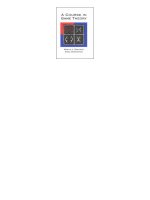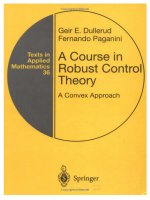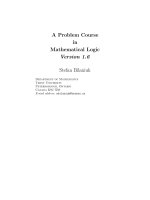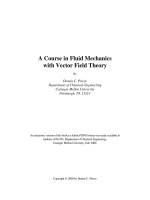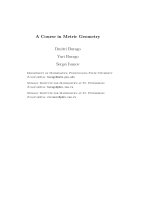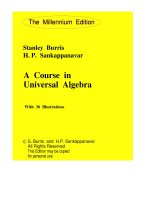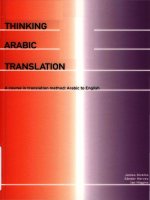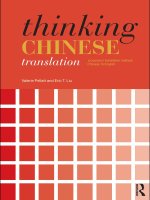A course in mathematical logic, yu i manin
Bạn đang xem bản rút gọn của tài liệu. Xem và tải ngay bản đầy đủ của tài liệu tại đây (23.84 MB, 296 trang )
Graduate Texts in Mathematics
53
Editorial Board
F. W. Gehring
P.R. Halmos
Managing Editor
C. C. Moore
Yu. I. Manin
A Course in
Mathematical Logic
Translated from the Russian by
Neal Koblitz
Springer Science+Business Media, LLC
Neal Koblitz
Yu. I. Manin
Department of Mathematics
Harvard University
Cambridge, Massachusetts 02138
CSA
V. A. Steklov Mathematical
Institute of the Academy of Sciences
Moscow V-333
UI. Vavilova 42
USSR
Editorial Board
P.R. Halmos
F. W. Gehring
C. C. Moore
Managing Editor
Department of Mathematics
University of Michigan
Ann Arbor, Michigan 48104
USA
Department of Mathematics
University of California
at Berkeley
Berkeley, California 94720
USA
Department of Mathematics
University of California
Santa Barbara, California 93106
USA
AMS Subject Classifications: 02-01, 02Bxx, 02Fxx
Library of Congress Cataloging in Publication Data
Manin, IV
A course in mathematical logic.
(Graduate texts in mathematics; 53)
Includes index.
1. Logic, Symbolic and mathematical.
II. Series.
77-1838
511'.3
QA9.M296
I.
Title.
All rights reserved.
No part of this book may be translated or reproduced in any form
without written permission from Springer Science+Business Media, LLC.
© 1977 by Springer Science+Business Media New York
Originally published by Springer-Verlag New York, Inc. in 1977
9 8 7 6 5 4 3 2
ISBN 978-1-4757-4385-2 (eBook)
ISBN 978-1-4757-4387-6
DOI 10.1007/978-1-4757-4385-2
To my son
Preface
1. This book is above all addressed to mathematicians. It is intended to be
a textbook of mathematical logic on a sophisticated level, presenting the
reader with several of the most significant discoveries of the last ten or
fifteen years. These include: the independence of the continuum hypothesis, the Diophantine nature of enumerable sets, the impossibility of finding
an algorithmic solution for one or two old problems.
All the necessary preliminary material, including predicate logic and the
fundamentals of recursive function theory, is presented systematically and
with complete proofs. We only assume that the reader is familiar with
"naive" set theoretic arguments.
In this book mathematical logic is presented both as a part of mathematics and as the result of its self-perception. Thus, the substance of the
book consists of difficult proofs of subtle theorems, and the spirit of the
book consists of attempts to explain what these theorems say about the
mathematical way of thought.
Foundational problems are for the most part passed over in silence.
Most likely, logic is capable of justifying mathematics to no greater extent
than biology is capable of justifying life.
2. The first two chapters are devoted to predicate logic. The presentation here is fairly standard, except that semantics occupies a very dominant position, truth is introduced before deducibility, and models of
speech in formal languages precede the systematic study of syntax.
The material in the last four sections of Chapter II is not completely
traditional. In the first place, we use Smullyan's method to prove Tarski's
theorem on the undefinability of truth in arithmetic, long before the
vii
Preface
introduction of recursive functions. Later, in the seventh chapter, one of
the proofs of the incompleteness theorem is based on Tarski's theorem. In
the second place, a large section is devoted to the logic of quantum
mechanics and to a proof of von Neumann's theorem on the absence of
"hidden variables" in the quantum mechanical picture of the world.
The first two chapters together may be considered as a short course in
logic apart from the rest of the book. Since the predicate logic has received
the widest dissemination outside the realm of professional mathematics,
the author has not resisted the temptation to pursue certain aspects of its
relation to linguistics, psychology, and common sense. This is all discussed
in a series of digressions, which, unfortunately, too often end up trying to
explain "the exact meaning of a proverb" (E. Baratynskii 1). This series of
digressions ends with the second chapter.
The third and fourth chapters are optional. They are devoted to complete proofs of the theorems of Godel and Cohen on the independence of
the continuum hypothesis. Cohen forcing is presented in terms of
Boolean-valued models; Godel's constructible sets are introduced as a
subclass of von Neumann's universe. The number of omitted formal
deductions does not exceed the accepted norm; due respects are paid to
syntactic difficulties. This ends the first part of the book: "Provability."
The reader may skip the third and fourth chapters, and proceed immediately to the fifth. Here we present elements of the theory of recursive
functions and enumerable sets, formulate Church's thesis, and discuss the
notion of algorithmic undecidability.
The basic content of the sixth chapter is a recent result on the Diophantine nature of enumerable sets. We then use this result to prove the
existence of versal families, the existence of undecidable enumerable sets,
and, in the seventh chapter, Godel's incompleteness theorem (as based on
the definability of provability via an arithmetic formula). Although it is
possible to disagree with this method of development, it has several
advantages over earlier treatments. In this version the main technical effort
is concentrated on proving the basic fact that all enumerable sets are
Diophantine, and not on the more specialized and weaker results concerning the set of recursive descriptions or the Godel numbers of proofs.
1
Nineteenth century Russian poet (translator's note). The full poem is:
We diligently observe tlte world,
We diligently observe people,
And we hope to understand tlteir deepest meaning.
But what is tlte fruit of long years of study?
What do tlte sharp eyes finally detect?
What does the haughty mind finally learn
At the height of all experience and thought,
What?-tlte exact meaning of an old proverb.
1828
Vlll
Preface
The last section of the sixth chapter stands somewhat apart from the
rest. It contains an introduction to the Kolmogorov theory of complexity,
which is of considerable general mathematical interest.
The fifth and sixth chapters are independent of the earlier chapters, and
together make up a short course in recursive function theory. They form
the second part of the book: "Computability."
The third part of the book, "Provability and Computability," relies
heavily on the first and second parts. It also consists of two chapters. All of
the seventh chapter is devoted to Godel's incompleteness theorem. The
theorem appears later in the text than is customary because of the belief
that this central result can only be understood in its true light after a solid
grounding both in formal mathematics and in the theory of computability.
Hurried expositions, where the proof that provability is definable is entirely omitted and the mathematical content of the theorem is reduced to
some version of the ''liar paradox," can only create a distorted impression
of this remarkable discovery. The proof is considered from several points
of view. We pay special attention to properties which do not depend on the
choice of Godel numbering. Separate sections are devoted to Feferman's
recent theorem on Godel formulas as axioms, and to the old but very
beautiful result of Godel on the length of proofs.
The eighth and final chapter is, in a way, removed from the theme of
the book. In it we prove Higman's theorem on groups defined by enumerable sets of generators and relations. The study of recursive structures,
especially in group theory, has attracted continual attention in recent
years, and it seems worthwhile to give an example of a result which is
remarkable for its beauty and completeness.
3. This book was written for very personal reasons. After several years
or decades of working in mathematics, there almost inevitably arises the
need to stand back and look at this research from the side. The study of
logic is, to a certain extent, capable of fulfilling this need.
Formal mathematics has more than a slight touch of self-caricature. Its
structure parodies the most characteristic, if not the most important,
features of our science. The professional topologist or analyst experiences a
strange feeling when he recognizes the familiar pattern glaring out at him
in stark relief.
This book uses material arrived at through the efforts of many mathematicians. Several of the results and methods have not appeared in
monograph form; their sources are given in the text. The author's point of
view has formed under the influence of the ideas of Hilbert, Godel, Cohen,
and especially John von Neumann, with his deep interest in the external
world, his open-mindedness and spontaneity of thought.
Various parts of the manuscript have been discussed with Yu. V.
Matijasevic, G. V. Cudnovskii, and S. G. Gindikin. I am deeply grateful to
all of these colleagues for their criticism.
lX
Preface
W. D. Goldfarb of Harvard University very kindly agreed to proofread
the entire manuscript. For his detailed corrections and laborious rewriting
of part of Chapter IV, I owe a special debt of gratitude.
I wish to thank Neal Koblitz for his meticulous translation.
Yu. I. Manin
Moscow, September 1974
Interdependence of Chapters
I
5
2
6
I
I
~8
/1\/
3 7
4
X
Contents
Part I
PROVABILITY
I Introduction to formal languages
I General information
2 First order languages
Digression: names
3 Beginners' course in translation
Digression: syntax
II Truth and deducibility
2
3
4
5
6
7
8
9
Unique reading lemma
Interpretation: truth, definability
Syntactic properties of truth
Digression: natural logic
Deducibility
Digression: proof
Tautologies and Boolean algebras
Digression: Kennings 1
Godel's completeness theorem
Countable models and Skolem's paradox
Language extensions
Undefinability of truth: the language SELF
3
3
6
9
10
16
20
20
24
30
34
38
48
51
56
58
64
69
73
1 "A metaphorical compound word or phrase used especially in Old English and Old Norse
poetry, e.g., 'swan-road' for 'ocean' "-Webster's New Collegiate Dictionary (translator's
note).
XI
Contents
10 Smullyan's language of arithmetic
ll Undefinability of truth: Tarski's theorem
Digression: self-reference
I2 Quantum logic
Appendix. The von Neumann Universe
III The continuum problem and forcing
I
2
3
4
5
6
7
8
9
The problem: results, ideas
A language of real analysis
The continuum hypothesis is not deducible in ~ Real
Boolean-valued universes
The axiom of extensionality is "true"
The axioms of pairing, union, power set, and regularity are "true"
The axioms of infinity, replacement, and choice are "true"
The continuum hypothesis is "false" for suitable B
Forcing
IV The continuum problem and constructible sets
I
2
3
4
5
6
7
Godel's constructible universe
Definability and absoluteness
The constructible universe as a model for set theory
The generalized continuum hypothesis is L-true
Constructibility formula
Remarks on formalization
What is the cardinality of the continuum?
74
78
81
82
95
103
103
108
112
118
123
126
131
138
I43
149
149
!53
157
160
I63
170
172
Part II
COMPUTABILITY
V Recursive functions and Church's thesis
I
2
3
4
5
Introduction. Intuitive computability
Partial recursive functions
Basic examples of recursiveness
Enumerable and decidable sets
Elements of recursive geometry
VI Diophantine sets and algorithmic undecidability
I
2
3
4
5
6
7
xii
The basic result
Plan of proof
Enumerable sets are D-sets
The reduction
Construction ot a special Diophantine set
The graph of the exponential is Diophantine
The graphs of the factorial and the binomial coefficients are
Diophantine
177
177
181
I86
190
200
206
206
209
2Il
213
2I6
220
22I
Contents
8 Versa! families
9 Kolmogorov complexity
223
225
Part III
PROVABILITY AND COMPUTABILITY
VII Godel's incompleteness theorem
I
2
3
4
5
6
7
8
Arithmetic of syntax
Incompleteness principles
Nonenumerability of true formulas
Syntactic analysis
Enumerability of deducible formulas
The arithmetical hierarchy
Productivity of arithmetical truth
On the length of proofs
VIII Recursive groups
I
2
3
4
5
6
Basic result and its corollaries
Free products and HNN-extensions
Embeddings in groups with two generators
Benign subgroups
Bounded systems of generators
End of the proof
Index
233
233
238
239
242
248
251
254
257
261
261
264
268
270
273
279
285
xiii
I
PROVABILITY
CHAPTER I
Introduction to formal languages
Gelegentlich ergreifen wir die Feder
Und schreiben Zeichen auf ein weisses Blatt,
Die sagen dies und das, es kennt sie jeder,
Es ist ein Spiel, das seine Regeln hat.
H. Hesse, "Buchstaben"
We now and then take pen in hand
And make some marks on empty paper.
Just what they say, all understand.
It is a game with rules that matter.
H. Hesse, "Alphabet"
(translated by Prof. Richard S. Ellis)
1 General information
1.1. Let A be any abstract set. We call A an alphabet. Finite sequences of
elements of A are called expressions in A. Finite sequences of expressions
are called texts.
We shall speak of a language with alphabet A if certain expressions and
texts are distinguished (as being "correctly composed," "meaningful," etc.).
Thus, in the Latin alphabet A we may distinguish English word forms and
grammatically correct English sentences. The resulting set of expressions
and texts is a working approximation to the intuitive notion of the
"English language."
The language Algol 60 consists of distinguished expressions and texts in
the alphabet {Latin letters} u {digits} u {logical signs} u {separators}.
Programs are among the most important distinguished texts.
3
I Introduction to formal languages
In natural languages the set of distinguished expressions and texts
usually has unsteady boundaries. The more formal the language, the more
rigid these boundaries are.
The rules for forming distinguished expressions and texts make up the
syntax of the language. The rules which tell how they correspond with
reality make up the semantics of the language. Syntax and semantics are
described in a metalanguage.
1.2. "Reality" for the languages of mathematics consists of certain classes
of (mathematical) arguments or certain computational processes using
(abstract) automata. Corresponding to these designations, the languages
are divided into formal and algorithmic languages. (Compare: in natural
languages, the declarative versus imperative moods, or-on the level of
texts-statement versus command.)
Different formal languages differ from one another, in the first place, by
the scope of the formalizable types of arguments-their expressiveness; in
the second place, by their orientation toward concrete mathematical theories; and in the third place, by their choice of elementary modes of
expression (from which all others are then synthesized) and written forms
for them.
In the first part of this book a certain class of formal languages is
examined systematically. Algorithmic languages are brought in episodically.
The "language-parole" dichotomy, which goes back to Humboldt and
Saussure, is as relevant to formal languages as to natural languages. In §3
of this chapter we give models of "speech" in two concrete languages,
based on set theory and arithmetic, respectively; because, as many believe,
habits of speech must precede the study of grammar.
The language of set theory is among the richest in expressive means,
despite its extreme economy. In principle, a formal text can be written in
this language corresponding to almost any segment of modern mathematics-topology, functional analysis, algebra, or logic.
The language of arithmetic is one of the poorest, but its expressive
possibilities are sufficient for describing all of elementary arithmetic, and
also for demonstrating the effects of self-reference a Ia Godel and Tarski.
1.3. As a means of communication, discovery, and codification, no formal
language can compete with the mixture of mathematical argot and formulas which is common to every working mathematician.
However, because they are so rigidly normalized, formal texts can
themselves serve as an object for mathematical investigation. The results of
this investigation are themselves theorems of mathematics. They arouse
great interest (and strong emotions) because they can be interpreted as
theorems about mathematics. But it is precisely the possibility of these and
still broader interpretations that determines the general philosophical and
human value of mathematical logic.
4
1 General information
1.4. We have agreed that the expressions and texts of a language are
elements of certain abstract sets. In order to work with these elements, we
must somehow fix them materially. In the modern European tradition (as
opposed to the ancient Babylonian tradition, or the latest American
tradition, using computer memory), the following notation is customary.
The elements of the alphabet are indicated by certain symbols on paper
(letters of different kinds of type, digits, additional signs, and also combinations of these). An expression in an alphabet A is written in the form of
a sequence of symbols, read from left to right, with hyphens when
necessary. A text is written as a sequence of written expressions, with
spaces or punctuation marks between them.
1.5. If written down, most of the interesting expressions and texts in a
formal language either would be physically extremely long, or else would
be psychologically difficult to decipher and learn in an acceptable amount
of time, or both.
They are therefore replaced by "abbreviated notation" (which can
sometimes turn out to be physically longer). The expression "xxxxxx" can
be briefly written "x · · · x (six times)" or "x 6 ." The expression "'rlz(z Ex
<=?z Ey)" can be briefly written "x = y." Abbreviated notation can also be
a way of denoting any expression of a definite type, not only a single such
expression; (any expression 101010 · · · 10 can be briefly written "the
sequence of length 2n with ones in odd places and zeros in even places" or
"the binary expansion of ~ (4n - I).")
Ever since our tradition started, with Vieta, Descartes, and Leibniz,
abbreviated notation has served as an inexhaustible source of inspiration
and errors. There is no sense in, or possibility of, trying to systematize its
devices; they bear the indelible imprint of the fashion and spirit of the
times, the artistry and pedantry of the authors. The symbols L, f, E are
classical models worthy of imitation. Frege's notation, now forgotten, for
"P and Q" (actually "not [if P, then not Q]," whence the asymmetry):
L---------------P
shows what should be avoided. In any case, abbreviated notation permeates mathematics.
The reader should become used to the trinity
formal text
~
written text
~
interpretation of text,
which replaces the unconscious identification of a statement with its form
and its sense, as one of the first priorities in his study of logic.
5
I
Introduction to formal languages
2 First order languages
In this section we describe the most important class of formal languages e1
-the first order languages-and give two concrete representatives of this
class: the Zermelo-Fraenkel language of set theory L 1Set, and the Peano
language of arithmetic LIAr. Another name for el is predicate languages.
2.1. The alphabet of any language in the class el is divided into six disjoint
subsets. The following table lists the generic name for the elements in each
subset, the standard notation for these elements in the general case, the
special notation used in this book for the languages L 1Set and L 1Ar. We
then describe the rules for forming distinguished expressions and briefly
discuss semantics.
The distinguished expressions of any language L in the class e1 are
divided into two types: terms and formulas. Both types are defined recursively.
2.2. Definition. Terms are the elements of the least subset of the expressions of the language which satisfies the two conditions:
(a) Variables and constants are (atomic) terms.
(b) If f is an operation of degree r and t 1, ••• , t, are terms, then
f(t 1, ••• , t,) is a term.
In (a) we identify an element with a sequence of length one. The
alphabet does not include commas, which are part of our abbreviated
notation: j(t 1, t 2 , t 3) means the same as j(t 1t2 t 3). In §I of Chapter II we
Language Alphabets
Names and Notation
Subsets of
the Alphabet
General
in L 1Set
in L 1Ar
V (inclusive or); 1\ (and);
--. (not); 'V (universal quantifier); 3 (existential quantifier)
connectives and
quantifiers
~(equivalent); ~(implies);
x,y, z, u, v, ... with indices
variables
constants
c . .. with indices
0 (empty set)
0 (zero); I (one)
operations of
degree
I, 2, 3, ...
J,
none
indices
+ (addition, degree 2);
· (multiplication, degree 2)
E (is an element
of, degree 2);
= (equals, degree 2)
= (equality, degree 2)
g, ... with
relations (predicates) of degree
I, 2, 3, ...
indices
parentheses
((left parenthesis); )(right parenthesis)
6
p, q, ... with
2 First order languages
explain how a sequence of terms can be uniquely deciphered despite the
absence of commas.
If two sets of expressions in the language satisfy conditions (a) and (b),
then the intersection of the two sets also satisfies these conditions. Therefore the definition of the set of terms is correct.
2.3. Definition. Formulas are the elements of the least subset of the
expressions of the language which satisfies the two conditions:
(a) If p is a relation of degree r and t 1, ••• , t, are terms, then
p(t 1, ••• , t,) is an (atomic) formula.
(b) If P and Q are formulas (abbreviated notation!), and xis a variable,
then the expressions
(P)~(Q),
(P)=)(Q), (P)V(Q), (P)I\(Q),
-.(P),
"'X (P),
3
X
(P)
are formulas.
It is clear from the definitions that any term is obtained from atomic
terms in a finite number of steps, each of which consists in "applying an
operation symbol" to the earlier terms. The same is true for formulas. In
Chapter II, §I we make this remark more precise.
The following initial interpretations of terms and formulas are given for
the purpose of orientation and belong to the so-called "standard models"
(see Chapter II, §2 for the precise definitions).
2.4.
EXAMPLES AND INTERPRETATIONS
(a) The terms stand for (are notation for) the objects of the theory.
Atomic terms stand for indeterminate objects (variables) or concrete
objects (constants). The term f(t 1, • •• , t,) is the notation for the object
obtained by applying the operation denoted by f to the objects denoted by
t 1, ••• , t,. Here are some examples from L 1Ar:
0 denotes zero;
I denotes one;
1) denotes two (1
+ (1,
+ I = 2 in the usual notation);
+ (1 + (1, 1)) denotes three;
· ( + {1, 1) + (1, 1)) denotes four (2 X 2 = 4).
Since this normalized notation is different from what we are used to in
arithmetic, in L 1Ar we shall usually write simply t 1 + t2 instead of + (t 1, t0
and t 1 • t2 instead of ·(t 1, t 2 ). This convention may be considered as another
use of abbreviated notation.
x stands for an indeterminate integer;
-
-
x +I (or +(x, I)) stands for the next integer.
7
I Introduction to formal languages
In the language L 1Set all terms are atomic:
x stands for an indeterminate set;
0 stands for the empty set.
(b) The formulas stand for statements (arguments, propositions, ... ) of
the theory. When translated into formal language, a statement may be
either true, false, or indeterminate (if it concerns indeterminate objects);
see Chapter II for the precise definitions. In the general case the atomic
formula p(t 1, ••. , t,) has roughly the foJlowing meaning: "The ordered
r-tuple of objects denoted by t 1, ••• , t, has the property denoted by p."
Here are some examples of atomic formulas in L 1Ar. Their general
structure is = (t 1, t 2 ), or, in nonnormalized notation. t 1 = t 2 :
0
= 1,
x+ I =y.
Here are some examples of formulas which are not atomic:
--, (o = 1),
= o)~(x +I= 1),
'Vx((x = O)V( --,(x·x = 0))).
(x
Some atomic formulas in L 1Set:
yEx
(y is an element of x),
and also 0 E y, x E 0, etc. Of course, normalized notation must have the
form E(xy), and so on.
Some nonatomic formulas:
3x('Vy( --,(y Ex))):
there exists an x of which no y is an element.
Informally this means: "The empty set exists." We once again recall that
an informal interpretation presupposes some standard interpretive system,
which will be introduced explicitly in Chapter II.
'Vy(y E z~y Ex):
z is a subset of x.
This is an example of a very useful type of abbreviated notation: four
parentheses are omitted in the formula on the left. We shall not specify
precisely when parentheses may be omitted; in any case, it must be
possible to reinsert them in a way that is unique or is clear from the
context without any special effort.
We again emphasize: the abbreviated notation for formulas are only
material designations. Abbreviated notation is chosen for the most part
with psychological goals in mind: speed of reading (possibly with a loss in
formal uniqueness), tendency to encourage useful associations and discourage harmful ones, suitability to the habits of the author and reader,
8
Digression: names
and so on. The mathematical objects in the theory of formal languages are
the formulas themselves, and not any particular designations.
Digression: names
On several occasions we have said that a certain object (a sign on paper,
an element of an alphabet as an abstract set, etc.) is a notation for, or
denotes, another element. A convenient general term for this relationship is
naming.
The letter x is the name of an element of the alphabet; when it appears
in a formula, it becomes the name of a set or a number; the notation x Ey
is the name of an expression in the alphabet A, and this expression, in turn,
is the name of an assertion about indeterminate sets; and so on.
When we form words, we often identify the names of objects with the
objects themselves: we say "the variable x," "the formula P," "the set z."
This can sometimes be dangerous. The following passage from Rosser's
book Logic for Mathematicians points up certain hidden pitfalls:
The gist of the matter is that, if we have a statement such as "3 is
greater than TI:" about the rational number ;"2 and containing a name ·• TI:"
of this rational number, one can replace this name by any other name of
the same rational number, for instance, 'T" If we have a statement such
as "3 divides the denominator of 'T,'" about a name of a rational number
and containing a name of this name, one can replace this name of the
name by some other name of the same name, but not in general by the
name of some other name, if it is a name of some other name of the same
rational number.
Rosser adds that "failure to observe such distinctions carefully can seldom
lead to confusion in logic and still more seldom in mathematics." However, these distinctions play a significant role in philosophy and in
mathematical practice.
"A rose by any other name would smell as sweet"-this is true because
roses exist outside of us and smell in and of themselves. But, for example,
it seems that Hilbert spaces only "exist" insofar as we talk about them, and
the choice of terminology here makes a difference. The word "space" for
the set of equivalence classes of square integrable functions was at the
same time a codeword for an entire circle of intuitive ideas concerning
"real" spaces. This word helped organize the concept and led it in the right
direction.
A successfully chosen name is a bridge between scientific knowledge
and common sense, between new experience and old habits. The conceptual foundation of any science consists of a complicated network of names
of things, names of ideas, and names of names. It evolves itself, and its
projection on reality changes.
9
I
Introduction to formal languages
3 Beginners' course in translation
3.1. We recall that the formulas in L 1Set stand for statements about sets;
the formulas in L 1Ar stand for statements about natural numbers; these
formulas contain names of sets and numbers, which may be indeterminate.
In this section we give the first basic examples of two-way translation
"argot~formal language." One of our purposes will be to indicate the
great expressive possibilities in L 1Set and L 1Ar, despite the extremely
limited modes of expression.
As in the case of natural languages, this translation cannot be given by
rigid rules, is not uniquely determined, and is a creative process. Compare
Hesse's quatrain with its translation in the epigraph to this book: the most
important aim of translation is to "understand ... just what they say."
Before reading further, the reader should look through the Appendix to
Chapter 1/: "The von Neumann Universe." The semantics implicit in L 1Set
relates to this universe, and not to arbitrary "Cantor" sets.
A more complete picture of the meaning of the formulas can be
obtained from §2 of Chapter II.
Translation from L 1Set to argot.
3.2. \ix( --,(x E 0)): "for all (sets) x it is false that xis an element of (the
set) 0" (or "0 is the empty set").
The second assertion is only equivalent to the first in the von Neumann
universe, where the elements of sets can only be sets, and not real
numbers, chairs, or atoms.
3.3. \iz(z E x~z Ey)~x = y: "if for all zit is true that z is an element of
x if and only if z is an element of y, then it is true that x coincides withy;
and conversely," or "a set is uniquely determined by its elements."
In the expression 3.3 at least six parentheses have been omitted; and the
subformulas z Ex, z Ey, x = y have not been normalized according to the
rules of el.
3.4. \iu \iv 3x \iz(z E x~(z = uV z = v)): "for any two sets u, v there
exists a third set x such that u and v are its only elements."
This is one of the axioms of Zermelo-Fraenkel. The set x is called the
"unordered pair of sets u, v" and is denoted { u, v} in the Appendix.
3.5. \iy \iz(((z Ey /\Y E x)=H E x);\(y Ex==;. i(Y Ey))): "the set x
is partially ordered by the relation E between its elements."
We mechanically copied the condition y Ex==;. i(Y Ey) from the
definition of partial ordering. This condition is automatically fulfilled in
the von Neumann universe, where no set is an element of itself.
10
3 Beginners' course in translation
A useful exercise would be to write the following formulas:
"x is totally ordered by the relation E ";
"xis linearly ordered by the relation E";
"x is an ordinal."
3.6. Vx(y E z): The literal translation "for all x it is true that y is an
element of z" sounds a little strange. The formula Vx 3x(y E z), which
agrees with the rules for constructing formulas, looks even worse. It would
be possible to make the rules somewhat more complicated, in order to rule
out such formulas, but in general they cause no harm. In Chapter II we
shall see that, from the point of view of "truth" or "deducibility," such a
formula is equivalent to the formulay E z. It is in this way that they must
be understood.
Translation from argot to L 1Set.
We choose several basic constructions having general mathematical significance and show how they are realized in the von Neumann universe, which
only contains sets obtained from 0 by the process of "collecting into a
set," and in which all relations must be constructed from E.
3.7. "xis the direct product y X
z.'~
This means that the elements of x are the ordered pairs of elements of y
and z, respectively. The definition of an unordered pair is obvious: the
formula
= y 1 V u = z 1))
"means," or may be briefly written in the form, x = {y 1, z 1} (compare 3.4).
Vu(u E x<=>(u
The ordered pair y 1 and z 1 is introduced using a device of Kuratowski and
Wiener: this is the set x 1 whose elements are the unordered pairs { y 1, y d
and {y 1, zt}.
We thus arrive at the formula
3Y2 3z2 {"x 1 = {y 2 , z2 }" A"Y2
= {y 1,yt}" l\"z 2 = {y 1, zt}"),
which will be abbreviated
XI=
(yl> zl)
and will be read: "x 1 is the ordered pair with first element y 1 and second
element z 1.'' The abbreviated notation for the subformulas is in quotes; we
shall later omit the quotation marks.
Finally, the statement "x = y X z" may be written in the form:
Vx 1 {x 1 E x<=>3y 1 3z 1 (y 1 Ey A z 1 E z A"x 1 = (y 1, z 1)")).
In order to remind the reader for the last time of the liberties taken in
abbreviated notation, we write this same formula adhering to all the
11
I
Introduction to formal languages
canons of
!~ 1 :
r
Vx,
[1 Elx,x)l
"" [ 3y, ( 3z, ( ( ( E (y, y II;\ ( E (z ,z))) ;\ ( 3y, ( 3z,( ( (vu( ( E(ux,))
~ ( ( = ( uy 2 )) V ( = ( uz 2 ))))) 1\ ('if u ( ( E ( uy 2 ))
=I~ (uy, II))) ;\ (V u (I
E ( uz,l
I
I= (( ~ (uy, I) VI~ (uz, II))))))))
Find the open parenthesis corresponding to the fifth closed parenthesis
In §I of Chapter II we give an algorithm for solving such problems.
end.
the
from
EXERCISE:
3.8. "j is a mapping from the set u to the set v."
First of all, mappings, or functions, are identified with their graphs;
otherwise, we would not be able to consider them as elements of the
universe. The following formula successively imposes three conditions on
f: f is a subset of u X v; the projection off onto u coincides with all of u;
and, each element of u corresponds to exactly one element of v:
'ilz(z Ej~(3u 1 3v 1 (u 1 E u 1\ v 1 E v 1\"z
=
(u 1, v 1)")))
1\ 'ilu 1 (u 1 E u~3v 1 3z(v 1 E v 1\"z = (u 1, v 1) " 1\z Ej))
1\'ilu 1 'ilv 1 'ilv2 (3z 1 3z 2 (z 1 Ej 1\ z 2 Ej /\"z 1 = (u 1, v 1)" /\"z 2 = (u 1, v 2)")
~v 1 =v 2 ).
EXERCISE:
Write the formula "f is the projection of y
X
z onto z."
3.9. "xis a finite set."
Finiteness is far from being a primitive concept. Here is Dedekind's
definition: "there does not exist a one-to-one mapping f of the set x onto a
proper subset." The formula:
-df("fis a mapping from x to x"/\ 'ilu 1 'ilu 2 'ilt: 1 'ilt: 2 (("(u 1, v 1)
/\'\u 2 , v2 ) Ef"/\ --l(u 1 = u 2 ))~
12
--.(
Ef"
c 1 = r 2 )) 1\ 3v 1 (t: 1 Ex 1\ --.3u 1
3 Beginners' course in translation
The abbreviation "(up v 1) Ej" means, of course, 3y("y =(up v 1) " N
f).
E
3.10. "x is a nonnegative integer."
The natural numbers are represented in the von Neumann universe by
the finite ordinals, so that the required formula has the form:
"x is totally ordered by the relation E "1\" x is finite."
ExERCISE:
Figure out how to write the formulas "x + y
x,y, z are integers ;;;. 0.
= z" and "x·y = z," where
After this it is possible in the usual way to write the formulas "x is an
integer," "xis a rational number," "xis a real number" (following Cantor
or Dedekind), etc., and then construct a formal version of analysis. The
written statements will have acceptable length only if we periodically
extend the language L 1Set (see §8 of Chapter II). For example, in L 1Set we
are not allowed to write term-names for the numbers I, 2, 3, ... (0 is the
name for 0), although we may construct the formulas "x is the finite
ordinal containing I element," "x is the finite ordinal containing 2 elements," etc. If we use such roundabout methods of expression, the simplest
numerical identities become incredibly long; but, of course, in logic we are
mainly concerned with the theoretical possibility of writing them.
3.11. "x is a topological space."
In the formula we must give the topology of x explicitly. We define the
topology, for example, in terms of the set y of all open subsets of x. We
first write that y consists of subsets of x and contains x and the empty set:
P 1:
'Vz(z Ey~'Vu(u E z~u E x))/\x Ey /\0 Ey.
The intersection w of any two elements u, v in y is open, i.e., belongs toy:
P2:
'Vu 'Vv 'Vw(( u Ey 1\ v Ey 1\ 'Vz((z E u f\z E v)¢=>z E w))~w Ey ).
It is harder to write "the union of any set of open subsets is open." We
first write:
P3 :
'Vu(u E z¢=>'Vv(v E u~v Ey)),
that is, "z is the set of all subsets of y." Then:
P4 :
'Vu 'Vw(( u E z 1\ 'Vv 1 (v 1 E W¢:::>3v(v E u 1\ v 1 E v)))~ w Ey ).
This means (taking into account P 3 , which defines z): "If u is any subset of
y, i.e., a set of open subsets of x, then the union w of all these subsets
belongs to y, i.e., is open." Now the final formula may be written as
follows:
13
Introduction to formal languages
I
The following comments on this formula will be ,reflected in precise
definitions in Chapter II, §§I and 2. The letters x, y have the same
meaning in all the P;, while z plays different roles: in P 1 it is a subset of x,
and in P 3 and P4 it is the set of subsets of x. We are allowed to do this
because, as soon as we "bind" z by the quantifier V, say in P 1, z no longer
stands for an (indeterminate) individual set, and becomes a temporary
designation for "any set." Where the "scope of action" of V ended, z can
be given a new meaning. In order to "free" z for later use, Vz was also put
before P 3 ~P4 •
Translation from argot to L 1Ar.
3.12. "x
3.13. "xis a divisor ofy": 3z(y
1).
=
Recall that the variables are names
x·z).
-
-
3.14. "xis a prime number": "I< x" 1\("y is a divisor of x"~(y =IVy=
x)).
3.15. "Fermat's_big theorem": 'flx 1 'flx 2 Vx 3 'flu("2 < u"(\"xf + x~ =
= 0"). It is not clear how to write the formula xf + x~ = xj'
in L 1Ar. Of course, for any concrete u = 1, 2, 3 there is a corresponding
atomic formula in L 1Ar, but how do we make u into a variable? This is not
a trivial problem. In the second part of the book we show how to find an
atomic formula p(x, u, y, z 1, ••• , zn) such that the assertion that
3z 1 • · · 3znp(x, u,y, z 1, . . . , zn) in the domain of natural numbers lS
equivalent toy= xu. Then xf + x~ = xj' can be translated as follows:
xj'"~"x 1 x 2 x 3
3y 1 312 3y3("xf=yi"(\"x~=y2"(\"xj'=YJ"NI +Yl=YJ).
The existence of such a p is a nontrivial number theoretic fact, so that here
the very possibility of performing a translation becomes a mathematical
problem.
r
3.16. "The Riemann hypothesis." The Riemann zeta-function (s) is defined
by the series L:;'= 1n-s in the halfplane Res> l. It can be continued
meromorphically onto the entire complex s-plane. The Riemann hypothesis is the assertion that the nontrivial zeros of r(s) lie on the line Re s = ~.
Of course, in this form the Riemann hypothesis cannot be translated into
L 1Ar. However, there are several purely arithmetic assertions which are
demonstrably equivalent to the Riemann hypothesis. Perhaps the simplest
of them is the following.
Let p,(n) be the Mobius function on the set of integers > I: it equals 0 if
n is divisible by a square, and equals (- 1)', where r is the number of prime
divisors of n, if n is square-free. We then have:
Riemann hypoth_,;, .. v, > 0 3x \ly [Y > x=>
14
[I"~' •(n)l <y'l>+•J].
